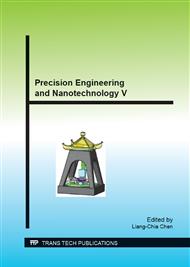p.378
p.384
p.392
p.398
p.402
p.411
p.417
p.423
p.430
Toolpath Planning and Simulation for Cutting Test of Non-Orthogonal Five-Axis Machine Tool
Abstract:
Owing to NAS 979 describes a cutting test for five-axis machine center with a universal spindle, several conditions for C-type machine tool have not been defined yet. This paper proposes a cutting test for a non-orthogonal swivel head and a rotary table type five-axis machine tool (C type) to evaluate its performance. The workpiece consists of 10 machining features. These features include the multi-axis simultaneous machining patterns and the positioning machining patterns. The flat end mill cutters are applied in each machining feature. Cutter location data for the test piece was generated using a commercial CAD/CAM system (UG) and converted to five-axis NC code using a postprocessor created in UG Post Builder. This UG postprocessor is verified through the developed postprocessor utilizing the modified D-H notation. It is also verified using VERICUT® solid cutting simulation software demonstrated the veracity of the generated five-axis NC code. The machining test is applicable for a variety of five-axis machine tool configurations.
Info:
Periodical:
Pages:
402-407
Citation:
Online since:
August 2014
Keywords:
Price:
Сopyright:
© 2015 Trans Tech Publications Ltd. All Rights Reserved
Share:
Citation:


